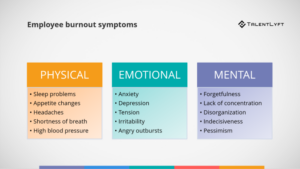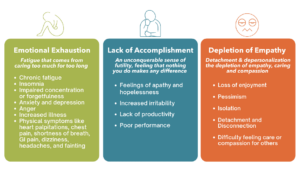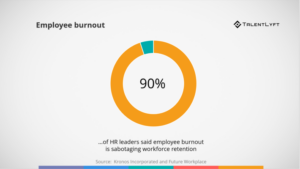
Do you know what’s more exhausting than running a marathon?
Dealing with employee burnout without a clue about its underlying components.
Unfortunately, this is a harsh reality for many leaders in today’s workplace.
Employee burnout can turn into a nightmare scenario for organizations, resulting in decreased productivity, increased turnover rates, and a toxic work environment. And relying on guesswork to tackle this issue is like playing with fire and hoping not to get burned.
What if there was a way for leaders to prevent employee burnout, boost productivity, and create a thriving work environment?
There is. And that’s exactly what this blog post is about.
We’ll cover:
- Spotting Burnout: The Warning Signs
- The 3 Components of Employee Burnout
- Effective Strategies For Preventing Burnout
Let’s get started
Spotting Burnout: The Warning Signs
Spotting employees who are experiencing burnout can sometimes be easy, but other times be challenging to identify.
Here are some of the clear-cut warning signs to look out for as a leader:
- Persistent fatigue and a lack of energy (even after adequate rest)
- Declining productivity
- Struggling to concentrate
- Making more mistakes than usual
- Changes in mood, such as increased irritability or cynicism
- Loss of interest in activities once enjoyed
- Physical symptoms (headaches, muscle tension)
- Withdrawal from social interactions
- Increased absenteeism
- Lack of motivation
- Decreased job satisfaction
- Chronic stress
- Lack of enthusiasm
- Emotional detachment
- Increased negativity
- Loss of creativity
- Decreased resilience
If you are a leader who is noticing one or multiple of these warning signs in your employees, it should start to raise some red flags that you can’t ignore.
But how should you go about addressing it?
The 3 Components of Employee Burnout
Before you can address anything, you need to understand WHY the signs of burnout are occurring.
According to the book “Burnout: The Secret to Unlocking the Stress Cycle” by Dr. Emily Nagoski (as referenced by Dr. Britt Andreatta in her book “Wired to Become”), she concluded that all of these warning signs can be categorized into three components:
Emotional exhaustion
This exhaustion happens when someone cares too much for too long. It makes them feel really tired all the time, but strangely enough, it can also make it hard to fall asleep. It’s like being stuck in a never-ending cycle of getting more and more tired. When this happens, it becomes difficult to focus or remember things, and they might feel more angry, worried, or sad. It can even make them more likely to get sick, and they might feel some strange things in their body like their heart beating fast, chest pain, trouble breathing, stomach pain, dizziness, headaches, or even feeling like they might faint.
Lack of accomplishment
This is when someone feels like everything they do doesn’t matter and there’s no way to change it. It also makes them feel like they don’t care and have no hope. Because of this, they might start becoming more easily annoyed or grumpy. The things they used to enjoy doing or the people they liked working with don’t make them feel excited anymore, and as a result, they don’t get much done and their work doesn’t turn out well.
Depletion of empathy
This happens when a person feels distant and disconnected. They can’t feel empathy or care for others, or even for themselves. It makes them stop enjoying things and they become more negative. They feel lonely and separate from others. They start to lose their happiness and kindness, and even if they know they need help, they don’t feel like getting it because they don’t care enough about themselves.
Effective Strategies For Preventing Burnout
Now that you know the warning signs of employee burnout and the core components of each, it’s time to start proactively addressing the issue (so you prevent it from happening in the first place).
Addressing Emotional Exhaustion
- Encourage work-life balance: Promote the importance of taking breaks, vacations, and personal time to recharge and reduce stress.
- Foster a supportive work environment: Establish open communication channels, encourage dialogue about challenges, and provide resources for mental health support.
- Recognize and reward achievements: Acknowledge employees’ efforts and accomplishments to boost morale and motivation.
Addressing Lack of Accomplishment
- Set realistic goals and expectations: Ensure that workload and targets are reasonable and attainable, preventing employees from feeling overwhelmed or constantly falling short.
- Provide professional development opportunities: Offer training programs, workshops, or mentorship to enhance employees’ skills, confidence, and sense of growth.
- Implement feedback and performance evaluations: Regularly assess and provide constructive feedback to help employees improve and track their progress.
Addressing Depletion of Empathy
- Promote a culture of empathy and understanding: Encourage team-building activities, promote collaboration, and foster a supportive atmosphere where employees feel valued and connected.
- Offer wellness programs: Provide resources such as counseling services, mindfulness training, or stress-management workshops to support employees’ mental and emotional well-being.
- Lead by example: Managers and leaders should demonstrate empathy and compassion, showing genuine concern for their team members’ welfare and modeling healthy work-life integration.
It’s Time To Extinguish The Burnout
There’s no debate that employee burnout is a challenge that leaders can’t afford to ignore.
By keeping an eye out for warning signs and understanding its three components (emotional exhaustion, lack of accomplishment, and depletion of empathy) leaders can take proactive steps to prevent it.
Strategies like promoting work-life balance, setting achievable goals, and fostering empathy go a long way in combating burnout. But at the end of the day, creating a supportive work environment that puts the health of its employees first not only benefits individuals…but also contributes to the overall success of the organization.
If you’re a leader within your organization, please don’t take the potential burnout of your employees for granted. Your people are your greatest asset, and it’s time to start prioritizing employee well-being and create a work culture where everyone thrives.



